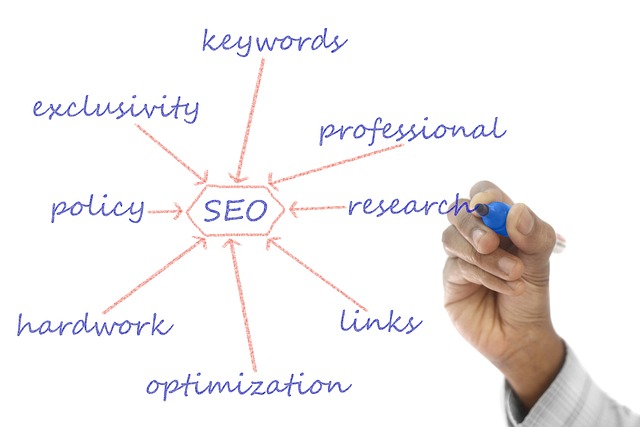In today's competitive digital marketing environment, SEO Ranking Strategies are vital for businesses aiming to stay visible online. These strategies encompass creativity and data analysis, delving into complex algorithms and user behavior to boost search engine rankings. Key components include keyword research for targeted content creation, on-page optimization for improved accessibility, technical SEO for site performance, and effective link building for authority. Local SEO is crucial for regional visibility, while mobile optimization caters to the majority of users. Continuous analytics and adaptation to algorithm updates are essential to succeed in this dynamic landscape.
“Unleash your website’s full potential with our comprehensive guide on advanced SEO ranking tactics. In today’s digital landscape, a strong online presence is paramount, and understanding sophisticated SEO strategies is key to success. From keyword research and on-page optimization to technical SEO and link building, this article provides an in-depth exploration of effective techniques. Discover how to craft content that captivates search engines, build a robust website foundation, earn high-quality backlinks, and dominate local search results. Get ready to transform your online visibility.”
Understanding Advanced Ranking Tactics: A Deep Dive into SEO

In the ever-evolving landscape of digital marketing, understanding advanced ranking tactics is paramount for any business aiming to stay visible online. SEO Ranking Strategies have become a crucible where creativity meets data analysis. By delving into the intricacies of Search Engine Optimization (SEO), marketers can unlock secrets to elevate their websites above the noise. This deep dive involves dissecting complex algorithms and user behaviors to craft effective strategies that resonate with both search engines and audiences.
Advanced tactics go beyond keyword optimization and quality content creation. They include structured data markup, mobile-first indexing, and building high-quality backlinks, among other sophisticated methods. These strategies require a symphony of technical, content, and link-building efforts to orchestrate a strong online presence. Staying abreast of industry trends and continually refining SEO techniques is essential in this dynamic realm where the rules of engagement are always evolving.
Keyword Research: Unlocking the Power of Relevant Terms

Keyword research is a fundamental aspect of SEO ranking strategies, acting as the key to unlocking online visibility and driving organic traffic. It involves identifying relevant terms and phrases that potential customers use when searching for products or services similar to yours. By understanding user intent behind these keywords, businesses can create content tailored to meet those specific needs, thus improving search engine rankings.
Using advanced research tools, you can uncover long-tail keywords—more specific and less competitive phrases—that often hold significant value. These keywords can help you target niche audiences who are actively searching for what your business offers. By incorporating these relevant terms into your website’s content, meta tags, and even URL structures, search engines will recognize your site as an authoritative source for those particular queries, boosting its ranking in search results.
On-Page Optimization: Crafting Content for Search Engines

On-Page optimization is a crucial aspect of crafting content that aligns with search engine algorithms, ultimately enhancing your site’s SEO ranking strategies. It involves meticulously optimizing individual web pages to ensure they are relevant and valuable to both users and search engines. This includes optimizing essential elements such as titles, headings, meta descriptions, and content itself, using strategic keywords naturally throughout the text. Well-optimized on-page content improves user experience, encouraging visitors to engage with your site for longer periods, which signals to search engines that your page offers a high-quality resource.
By implementing best practices in on-Page SEO, you can increase the visibility and accessibility of your website’s pages. This process involves careful keyword research to identify relevant terms your target audience is searching for and incorporating them into your content without over-optimizing. Additionally, creating structured and coherent content with internal linking helps search engines understand your site’s hierarchy and context, making it easier for them to index and rank your pages accordingly.
Technical SEO: Building a Solid Foundation for Your Site

Technical SEO plays a pivotal role in establishing a robust foundation for your website’s online visibility and ultimate success in search engine rankings. It involves optimizing the technical aspects of your site, ensuring it’s easily accessible and understood by search engines like Google. A solid Technical SEO strategy begins with a comprehensive audit to identify and rectify any issues that could hinder performance, such as broken links, slow loading times, or mobile usability problems.
By addressing these fundamentals, you create a seamless user experience, which is a key factor in search engine algorithms. Additionally, implementing structured data markup, optimizing site structure for crawlability, and ensuring proper XML sitemaps can significantly improve your site’s discoverability. These strategies collectively contribute to better indexing, higher click-through rates, and ultimately, advanced SEO ranking strategies that drive organic traffic and boost online visibility.
Link Building Strategies: Earning High-Quality Backlinks

Link building is a critical component of effective SEO ranking strategies. Earning high-quality backlinks from reputable sources can significantly boost your website’s authority and visibility in search engine results pages (SERPs). This process involves cultivating relationships with influential websites within your niche, creating valuable content that naturally attracts links, and utilizing guest blogging, press releases, and broken link building techniques to acquire relevant backlinks.
Focusing on organic link acquisition rather than purchasing links from low-quality sources is key. High-quality backlinks not only refer to sites with high domain authority but also those that align closely with your industry or niche. This contextually relevant linking signals to search engines that your website offers valuable content, enhancing its overall SEO ranking potential.
Local SEO Tactics: Dominating Regional Search Results

In the competitive digital landscape, Local SEO Tactics are essential strategies for businesses aiming to dominate regional search results and attract nearby customers. Optimizing your online presence starts with ensuring your Google My Business profile is complete and accurate, including up-to-date business hours, relevant categories, and a compelling description that incorporates local keywords. This serves as a cornerstone for your location’s visibility on Google Maps and local search queries.
Additionally, leveraging local citations from reputable directories and review sites bolsters your SEO Ranking Strategies. Consistent NAP (Name, Address, Phone number) information across these platforms reinforces your business’s credibility with both search engines and potential clients. Engaging in online reviews encourages satisfied customers to share their experiences, further enhancing your local search rankings and fostering a positive brand image among your target audience.
Mobile Optimization: Ensuring a Seamless User Experience

In today’s digital era, mobile optimization is no longer an option but a necessity for effective SEO ranking strategies. With a vast majority of users accessing online content via their smartphones and tablets, search engines prioritize websites that offer a seamless user experience across all devices. This involves optimizing website speed, ensuring responsive design, and simplifying navigation to cater to the smaller screens and faster connectivity often associated with mobile internet. By implementing these tactics, businesses can improve user engagement, reduce bounce rates, and signal to search algorithms that their site is a valuable resource worthy of higher rankings.
A key aspect of mobile optimization is prioritizing content delivery network (CDN) usage to reduce page load times. CDNs distribute website content across multiple servers worldwide, enabling faster access for users regardless of their geographical location. Additionally, leveraging AMP (Accelerated Mobile Pages) allows for the creation of lightweight web pages that load instantly, enhancing user experience and boosting search engine rankings. These strategies collectively contribute to a stronger online presence and better SEO performance, ultimately driving more organic traffic to mobile-friendly websites.
Analytics and Monitoring: Tracking Your Ranking Progress

Analytics and monitoring are vital components of any effective SEO ranking strategy. By tracking your website’s performance and ranking progress, you gain invaluable insights into what works and what needs improvement. Utilize tools like Google Analytics and Search Console to monitor key metrics such as organic traffic, keyword rankings, and backlink profiles. These platforms provide data-driven evidence of your site’s visibility and help identify trends over time.
Regularly reviewing these analytics allows you to make informed decisions about your SEO efforts. For instance, if a particular page isn’t gaining traction, you can analyze its content, structure, and surrounding keywords to implement targeted optimizations. Conversely, pages that see significant traffic growth can highlight successful strategies that should be replicated across your site. This continuous monitoring ensures your SEO Ranking Strategies remain agile and responsive to the ever-changing digital landscape.
Staying Ahead: Adapting to Evolving SEO Algorithms

In the ever-changing digital landscape, staying ahead in SEO means constantly adapting to algorithm updates. Google and other search engines regularly refine their ranking factors, with a focus on rewarding content that offers genuine value to users. This requires SEO Ranking Strategies that are not just reactive but proactive. Marketers must embrace a dynamic approach, continually refining their tactics to align with the latest trends and best practices.
By closely monitoring industry news and utilizing tools for algorithm tracking, professionals can anticipate changes. This foresight enables them to adjust content strategies, optimize on-page elements, and refine link building efforts accordingly. Advanced Ranking Tactics involve understanding that SEO is not a one-time task but an ongoing process that demands flexibility and a deep understanding of user intent.
